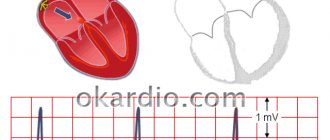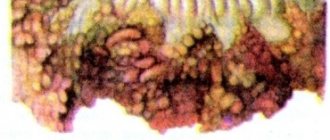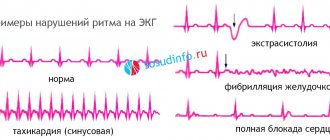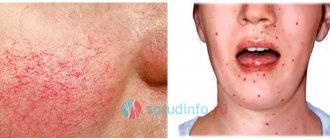What is hyperemia?
Hyperemia is an excessive overflow of the blood vessels of any organ or part of the body with blood, in which characteristic redness appears in those places, such as the skin.
The main mechanism for the appearance of hyperemia is an increased influx of arterial blood or obstructed outflow of venous blood. In this regard, hyperemia is divided into two main types - arterial (active, in which the flow of blood occurs) and venous (passive, in which the outflow of venous blood is hampered). We will return to a more detailed classification later, but now let's look at the causes of hyperemia.
Hyperemia often occurs in women who spend a lot of time in high heels.
Hyperemia - ICD
ICD-9: 780.99.
Arterial hyperemia. Types, etiology and pathogenesis. Meaning.
⇐ PreviousPage 2 of 21Next ⇒Arterial hyperemia is an increase in blood supply to an organ or tissue due to increased blood flow through dilated arteries and arterioles.
Arterial hyperemia can be caused by the increased effect of ordinary physiological stimuli (sun rays, heat, etc.), as well as the effect of pathogenic factors (biological, mechanical, physical). Expansion of the lumen of the afferent arteries and arterioles is achieved through the implementation of neurogenic and humoral mechanisms or a combination of them.
Neurogenic mechanism. There are neurotonic and neuroparalytic varieties of the neurogenic mechanism for the development of arterial hyperemia. The neurotonic mechanism is characterized by the predominance of the effects of parasympathetic vasodilatory influences on the vascular wall (due to acetylcholine) compared to sympathetic influences (an example is redness of the face and neck during pathological processes in the internal organs - ovaries, heart; a classic example of neurotonic hyperemia in humans is the color of shame or anger on the cheeks). The neuroparalytic mechanism consists of a decrease or absence of sympathetic effects on the walls of arteries and arterioles (for example, when the sympathetic nerves going to the skin of the upper extremities or ears are damaged, their redness is noted; a classic example of neuroparalytic hyperemia in humans is the so-called frosty blush on the cheeks). The so-called “lightning signs” (areas of arterial hyperemia along the passage of current during a lightning strike) are considered to be a manifestation of the neuroparalytic effect of electric current.
Humoral mechanism. It is caused by the action of vasodilators on the arteries and arterioles, which locally increase and have a vasodilating effect. Vasodilation is caused by histamine, bradykinin, lactic acid, excess carbon dioxide, nitric oxide, adenosine, hypoxia, acidosis of the tissue environment, some prostaglandins, etc.
Types of arterial hyperemia:
There are physiological and pathological arterial hyperemia.
Physiological arterial hyperemia includes working (functional) and reactive (post-ischemic) hyperemia. Working hyperemia is caused by the metabolic needs of an organ or tissue due to an increase in their functioning. For example, hyperemia in a contracting muscle during physical work, hyperemia of the pancreas and intestinal wall during digestion, hyperemia of the secreting endocrine gland, hyperemia of the salivary glands. An increase in myocardial contractile activity leads to an increase in coronary blood flow; activation of the brain is accompanied by an increase in its blood supply. Reactive (post-ischemic) hyperemia is observed after a temporary cessation of blood flow (temporary ischemia) and is protective and adaptive in nature.
Pathological arterial hyperemia develops in a zone of chronic inflammation, in a place of prolonged exposure to solar heat, when the sympathetic nervous system is damaged (in some infectious diseases). Pathological arterial hyperemia of the brain is observed during a hypertensive crisis. There are neurogenic (neurotonic and neuroparalytic) and myoparalytic.
Microcirculation during arterial hyperemia . Changes in microcirculation during arterial hyperemia occur as a result of expansion of the afferent arteries and arterioles. Due to an increase in the arteriovenous pressure difference in microvessels, the speed of blood flow in the capillaries increases, intracapillary pressure increases, and the number of functioning capillaries increases
The volume of the microvasculature during arterial hyperemia increases mainly due to an increase in the number of functioning capillaries. For example, the number of capillaries in working skeletal muscles is several times higher than in non-working muscles. In this case, the functioning capillaries expand slightly and mainly near the arterioles. When closed capillaries open, they first turn into plasma capillaries (capillaries that have a normal lumen, but contain only blood plasma), and then whole blood begins to circulate in them - plasma and formed elements. The opening of capillaries during arterial hyperemia is facilitated by an increase in intracapillary pressure and change.
Symptoms of arterial hyperemia . The color of the organ during arterial hyperemia becomes scarlet-red due to the fact that the superficial vessels in the skin and mucous membranes are filled with blood with a high content of red blood cells and an increased amount of oxyhemoglobin, since as a result of the acceleration of blood flow in the capillaries during arterial hyperemia, oxygen is only partially used by the tissues, i.e. e. arterialization of venous blood takes place
The temperature of superficial tissues or organs increases due to increased blood flow in them, since the balance of heat supply and loss shifts in a positive direction. In the future, an increase in temperature itself can cause an increase in oxidative processes and contribute to an even greater increase in temperature.
Tissue turgor (tension) increases as microvessels expand, fill with blood, and the number of functioning capillaries increases.
The meaning of arterial hyperemia:
The positive value of arterial hyperemia is associated with an increase in both the delivery of oxygen and nutrients to tissues and the removal of metabolic products from them, which is necessary, however, only in cases where the tissue need for this is increased. For example, arterial hyperemia that occurs during contraction skeletal muscles, increased secretion of glands, increased activity of neurons, etc., are called functional. Under pathological conditions, arterial hyperemia can also have a positive effect if it compensates for certain disorders. Such hyperemia occurs in cases where the tissue experiences a lack of blood supply. For example, if the local blood flow was previously weakened (ischemia) due to narrowing of the afferent arteries, the subsequent hyperemia, called post-ischemic, has a positive, i.e. compensatory value. At the same time, more oxygen and nutrients are brought into the tissue, and metabolic products that accumulated during ischemia are better removed. Examples of arterial hyperemia of a compensatory nature include local dilatation of the arteries and increased blood flow in the area of inflammation.
A negative value of arterial hyperemia can occur when the need to increase blood flow is absent or the degree of arterial hyperemia is excessive. In these cases, it can cause harm to the body. In particular, due to a local increase in pressure in the microvessels, hemorrhages into the tissue may occur as a result of rupture of the vascular walls (if they are pathologically changed) or diapedesis, when red blood cells leak through the walls of the capillaries; tissue swelling may also develop. These phenomena are especially dangerous in the central nervous system.
⇐ Previous2Next ⇒
Causes of hyperemia
The main causes of blood overflow of blood vessels, or hyperemia, which we actually already said, are:
- Increased arterial blood flow;
- Obstructed outflow of venous blood.
Factors that contribute to a rush of blood (arterial hyperemia) may be:
- Friction of a body part with another surface, object, clothing (for example, tight shoes or underwear);
- Impact on the body of increased or decreased ambient temperature;
- Increased or high body temperature;
- Exposure to body parts or organs of acids, alkalis;
- Entry into the body of foreign proteins and microorganisms, and its poisoning with toxins produced by pathological microflora, especially infection;
- Emotional experiences (stress, feelings of shame, joy, anger);
- Increased heart rate;
- Low atmospheric pressure;
- Accelerated lymph circulation;
- Use of substances that affect blood flow (caffeine, alcohol, drugs, medications, smoking and others);
- Animal and insect bites (mosquito, wasp or bee bite, ant, snake);
- Allergies to food, synthetic fabrics, detergents, etc.
Read also Vitamin B9 (Folic acid). Functions, sources and uses of folic acid
Factors that contribute to obstruction of blood outflow (venous hyperemia) may be:
- Squeezing or narrowing of large vein trunks, which is usually caused by scars, hernias, tumors, prolapsed kidneys, pregnancy, tight watch straps, jewelry;
- Prolonged “abnormal” body position, especially sitting or in an upright position, prolonged stay of the limbs without movement;
- Disturbances in the functioning of the heart (weakening of its pumping activity);
- Walking in high heels.
Causes of hyperemia on the skin
The diverse range of causes of skin hyperemia can be divided into two large groups:
- physiological (normal, natural);
- pathological.
Hemorrhoids kill the patient in 79% of cases.
Normally, a person’s skin turns red against the background of mental arousal in moments of strong emotions or stressful situations (joy, shame, excitement, anger). In this case, the walls of blood vessels expand under the influence of hormones. A decrease or increase in ambient temperature (water, air) also causes physiological redness of the skin. Everyone has noticed that in the cold the nose turns red, and in the bathhouse the entire surface of the body turns red. During physical activity, diffuse redness appears in one or more areas of the body.
Pathological hyperemia of the skin:
- occurs against the background of febrile conditions;
- manifests itself locally over foci of inflammation (around joints, wounds, boils or abscesses);
- becomes one of the symptoms of allergic reactions (urticaria, atopic dermatitis);
- in case of carbon monoxide poisoning, the skin becomes scarlet due to the formation of carboxyhemoglobin in the blood, which has a bright purple tint;
- In addition, unhealthy redness can be caused by a lack of oxygen in the blood (hypoxia) or excess lactic acid in the tissues (acidosis).
Demarcated spots of hyperemia in different parts of the body appear with infectious erythema, tuberculosis, streptococcal infections, sarcoidosis, ulcerative colitis and chronic foci of infection (tonsillitis, pyelonephritis).
In case of severe liver damage, persistent redness is observed on the palms and soles of the patient, the so-called “palmar erythema” appears.
A violent hyperemic reaction of the skin is accompanied by thermal and chemical burns.
Mechanical irritants such as massage, rubbing or scratching can also increase blood flow to the epidermis and cause local redness.
Symptoms of hyperemia
Signs of hyperemia largely depend on its type.
The main signs of arterial hyperemia:
- Redness of the skin at the site of blood flow;
- The hyperemic area increases in volume and swells;
- Dilatation of arterial vessels;
- Acceleration of blood flow in vessels;
- In the hyperemic area, blood pressure increases;
- The difference in the amount of oxygen in the arteries and veins decreases;
- Pulsation in those vessels where this was not previously the case;
- Accelerated lymph formation and increased lymph flow;
- At the site of hyperemia, tissue temperature rises.
The main signs of venous hyperemia:
- The color of the skin at the site of hyperemia becomes bluish or dark blue;
- The body temperature in a given place decreases;
- The hyperemic area increases in volume and swells.
Other symptoms of hyperemia include:
- Rapid breathing;
- Increased heart rate;
- Redness of the mucous membranes;
- Swelling;
- Bleeding;
- Inhibition of the activity of organs and systems.
Complications of hyperemia
Among the complications of hyperemia are:
- Brain swelling;
- Hydrocephalus;
- Death.
Classification
Typification is carried out for a number of reasons. To be specific.
According to the criterion of the mechanism, the already mentioned two forms of violation can be distinguished:
- Arterial congestion is the result of excessive blood flow to tissues. As a rule, it becomes the result of vasodilation, deviations in the quality of tone regulation against the background of hormonal imbalance, pathologies or temporary disorders of the nervous system, and other issues. Occurs in approximately 60% of cases.
- Venous hyperemia is a consequence of insufficiently rapid outflow of liquid tissue from the skin and mucous membranes. It develops as a result of pathologies of the vessels themselves, less often against the background of other factors. Characterized by the same symptoms. It will be possible to differentiate the types only after an objective diagnosis.
- Separately, we can talk about induced forms of deviation from the norm. For example, vacant hyperemia is the result of a sharp drop in local barometric pressure.
A similar effect is observed, for example, after cupping therapy (the effect of vacuum). Such forms are almost always associated with the action of the person himself.
Another way of classification is localization. As a rule, the disorder affects the mucous membranes and skin.
To elaborate on this point, the following locations are distinguished:
- Skin hyperemia is a generalized type of disorder that includes all others. Accompanied by redness of the area, itching, a feeling of heat: characteristic manifestations.
- Damage to the limbs. Arms and legs suffer equally often.
- Redness of the mucous membranes. Nose, mouth, pharynx, genitals. The essence depends on the specific diagnosis and the severity of the pathological process.
- Hyperemia of the face or torso. Both a focal variant is possible (for example, only the face turns red), and a diffuse one: the skin tone changes throughout the body.
- Possible damage to the eyes (usually the conjunctiva). Internal organs (stomach and others, the phenomenon is detected during instrumental diagnostics).
Depending on the origin of the symptom, two more types of the disorder are called:
- Physiological. Has a natural nature. For example, after intensive rubbing of an area of the skin, thermal effects, changes in blood pressure due to physical activity.
This is a temporary manifestation that goes away on its own as soon as the provoking factor ceases to act.
- Pathological variety. The result of the course of a particular disease. There are many of them.
Separately, they talk about the collateral form. In which hyperemia covers the tissues surrounding the immediate site of the lesion.
The other option is local. Point areas. In this case, pronounced asymmetry and irregular coloring are possible, which clearly indicates the pathological origin of the phenomenon. Except for some individual cases.
We can also talk about local and general, generalized forms, acute and chronic types.
Attention:
All classifications are used to clarify the nature of the process and its more accurate documentary description.
Types of hyperemia
The classification of hyperemia includes the following types of this condition:
According to the development mechanism:
Active hyperemia (arterial) – increased blood flow. Can be divided into:
- neurotonic hyperemia (due to irritation of the nerves that dilate blood vessels);
- neuroparalytic hyperemia (with paralysis of the nerves that constrict blood vessels);
Read also Diet No. 10c (Table No. 10c): nutrition for atherosclerosis
Passive hyperemia (venous) – difficulty in the outflow of venous blood.
Mixed form – both variants of development of this condition are observed.
By etiology:
- Physical;
- Mechanical;
- Chemical;
- Biological;
- Emotional.
By localization:
- Skin hyperemia;
- Hyperemia of the brain;
- Hyperemia of the lungs;
- Hyperemia of the mucous membrane;
- Hyperemia of the eyes (conjunctiva);
- Collateral hyperemia (develops when the main artery is blocked).
With the flow:
- Acute hyperemia;
- Chronic hyperemia.
Types of hyperemia and their symptoms
Skin hyperemia (this is a phenomenon that requires to eliminate not only the cause of redness, but also its type) is classified by dermatologists into several types.
Arterial active hyperemia
Active hyperemia is characterized by an excessive increase in venous blood flow. In this condition, the affected areas of the skin swell and increase in size.
In the vast majority of cases, there is a local increase in body temperature, as well as a disruption of lymph flow, in particular its excessive acceleration. Active hyperemia by nature of its origin can be mechanical or nervous.
Mechanical hyperemia
Mechanical hyperemia occurs due to an increase in the rate of normal functioning of the heart and vascular system. Another condition for its formation is a sharp drop in atmospheric pressure, in particular its decrease.
Externally, this type of active condition usually involves the presence of red spots on the skin.
Hyperemia of nervous origin
Skin hyperemia of nervous origin is usually caused by a disorder of the vascular-motor nervous system. This is a condition where the nerves responsible for the dilation and constriction of blood vessels are irritated or damaged.
As a result of such dysfunctions, the increasing blood flow cannot circulate normally in the body, which provokes overcrowding of blood vessels and further redness of the skin. In this case, most often there is a uniform change in the shade of the skin.
Venous passive hyperemia
Venous passive hyperemia is also called venous stagnation. This condition is characterized by obstruction of blood vessels or the presence of impeding circumstances for blood circulation through them. At the same time, the blood flow itself remains unchanged both in terms of speed and volume. Redness of the skin is usually observed in the lower extremities of the patient.
This is a sign of the presence of varicose veins or chronic venous insufficiency. If such manifestations are ignored, a person risks encountering the need for drug treatment of thrombosis or thrombophlebitis in the future.
Among the external manifestations of passive stagnation are:
- visible expansion of veins;
- decreased tone of the walls of blood vessels and capillaries;
- local formation of swelling;
- local decrease in skin temperature;
- blue discoloration of individual parts of the body or the skin on them.
Venous hyperemia is most often provoked by a person remaining in one (not always comfortable) position for a long time. For example, during long journeys by transport, a person’s lower limbs are almost all the time below in an immobilized state.
In addition, skin redness of this type can occur due to heart failure or a decrease in the venous lumen.
Mixed hyperemia
By mixed hyperemia, experts usually mean an intermediate period, which is a transition between the active and passive forms of blood outflow. This fact determines the combination of the characteristic features of arterial and venous hyperemia among the mixed-type signs.
For example, at the transition stage, there is a preservation of accelerated blood circulation (active form) with a beginning decrease in the tone of the capillaries and veins (characteristic of the passive form).
Manifestations of mixed hyperemia include:
- expansion of capillaries, vessels and venous ends;
- increase in the number of functioning vessels;
- slow decrease in the rate of blood outflow;
- the appearance of red spots on certain parts of the patient’s body.
The causes of this type of condition are usually not determined, since it is physiological in the absence of attempts to eliminate the circumstances that provoked the active stage of hyperemia.
At this stage of circulatory disorders, it is possible to use external influence methods to regulate the condition of blood vessels and veins (for example, procedures with medical cups or mustard plasters).
Diagnosis of hyperemia
Diagnosis of hyperemia includes a comprehensive examination of the body, because this condition is not a disease but a symptom, so the research is aimed at detecting possible diseases.
Hyperemia often accompanies diseases such as diseases of the respiratory system (sore throat, pharyngitis, laryngitis), eyes (conjunctivitis), cardiovascular system (ischemia, thrombosis, thrombophlebitis, embolism) and skin (dermatitis, eczema), allergies.
Among the methods for studying the body during hyperemia are:
- History, general examination of the patient;
- Electrocardiography (ECG);
- Computed tomography (CT);
- Ultrasound examination (ultrasound);
- General blood analysis.
What it is?
Hyperemia is an increase in blood flow to the skin, congestion of blood vessels. It manifests itself in severe redness of the skin. The word “hyperemia” itself, translated from ancient Greek, means “plethora”.
You can see what this skin pathology looks like in adults in this photo:
But in this picture you can see what it looks like in children:
There are two types of hyperemia:
- Arterial. Characterized by excessive influx of arterial blood.
- Venous. Occurs due to obstructed outflow of venous blood.
This disease is also classified according to the prevalence of the pathology:
- Generalized. Characterized by damage to the entire facial skin, except the forehead. With this form, redness can appear in several places on the body at the same time, for example, on the neck, chest or back.
- Focal. In this case, a specific skin area remains affected, most often the nose and cheeks, sometimes only on one half of the face.
Facial hyperemia can occur in both acute and chronic forms. The chronic course of the disease is observed when metabolism or the functioning of internal organs is impaired; the acute form manifests itself in the form of a severe allergic reaction or infection.
Most often, people over forty years of age are susceptible to this disease. The female part of the population is more susceptible than the male part; sometimes this kind of redness appears in children.
Hyperemia is often observed in infants from the first month of life to one year of age. This slight physiological redness is called erythema and usually goes away on its own. But if a red rash on the baby’s skin lasts longer than two weeks, then this means the presence of pathology. The disease manifests itself not only on the child’s cheeks, it can appear in other places.
Treatment of hyperemia
Treatment of hyperemia includes the following recommendations:
1. Consult a doctor (generalist, dermatologist);
2. Eliminate the influence on the body of the factor that caused the hyperemia;
3. Wash hyperemic (affected) areas of the skin with warm water, but wipe the body in this area only with a soft cloth;
4. The doctor may prescribe drugs aimed at improving blood circulation and microcirculation: Vazaprostan, Cordafen, Curantil, Persantine, Reomacrodex.
5. For stress and emotional distress, sedatives (calming agents) are prescribed: “Valerian”, “Tenoten”.
6. In the case of skin diseases, the affected area is usually treated with special solutions, depending on the specific disease and its cause.
7. The presence of infectious diseases includes the use, depending on the pathogen, of antibacterial, antiviral or antifungal drugs;
8. To cleanse the body of toxins produced by pathogenic microflora (staphylococci, streptococci, pneumococci and others), detoxification therapy is prescribed - Atoxil, Enterosgel and other means.
Read also Iron (Fe) - role in the body, application, daily requirement, sources
9. In case of severe itching, which, when scratched, could cause a rush of blood and swelling, you can take an antihistamine - Suprastin, Claritin.
10. In case of cerebral edema, it is necessary to observe bed and semi-bed rest, rest, and when lying down, the head should be elevated.
11. Eat light, easily digestible foods high in vitamins and microelements (salads, fresh vegetables and fruits, buckwheat, light soups).
12. The doctor may also prescribe a massage course.
13. Walking barefoot on wet grass has a beneficial effect on the body.
14. Sometimes the doctor prescribes procedures such as body rubdown, contrast shower, steam baths, leg wraps, stimulating compress on the stomach and others.
What should you not do if you have hyperemia?
1. To wash or treat the hyperemic area, do not use products that dry the skin - soap, alcohol and others.
2. Do not apply protective creams or ointments to the affected areas.
3. Avoid factors that could potentially cause redness, which we have already discussed in the paragraph “causes of hyperemia” - overheating or hypothermia of the body, chapping, eating spicy food or alcoholic beverages, wearing tight clothing, and others.
Hyperemia - causes, symptoms, types and treatment of hyperemia
Good day, dear readers!
Most of us are probably familiar with that very feeling when we feel a “burning face”, or when an experience or physical activity literally makes us blush. Sometimes, for various reasons, a red spot appears on the skin, as if with swelling. These and many other similar signs may be hyperemia. Let's look at this “reddening” condition in more detail. So…
What is hyperemia?
Hyperemia is an excessive overflow of the blood vessels of any organ or part of the body with blood, in which characteristic redness appears in those places, such as the skin.
The main mechanism for the appearance of hyperemia is an increased influx of arterial blood or obstructed outflow of venous blood.
In this regard, hyperemia is divided into two main types - arterial (active, in which the flow of blood occurs) and venous (passive, in which the outflow of venous blood is hampered).
Hyperemia often occurs in women who spend a lot of time in high heels.
Causes of hyperemia
The main causes of blood overflow of blood vessels, or hyperemia, which we actually already said, are:
- Increased arterial blood flow;
- Obstructed outflow of venous blood.
Factors that contribute to a rush of blood (arterial hyperemia) may be:
- Friction of a body part with another surface, object, clothing (for example, tight shoes or underwear);
- Impact on the body of increased or decreased ambient temperature;
- Increased or high body temperature;
- Exposure to body parts or organs of acids, alkalis;
- Entry into the body of foreign proteins and microorganisms, and its poisoning with toxins produced by pathological microflora, especially infection;
- Emotional experiences (stress, feelings of shame, joy, anger);
- Increased heart rate;
- Low atmospheric pressure;
- Accelerated lymph circulation;
- Use of substances that affect blood flow (caffeine, alcohol, drugs, medications, smoking and others);
- Animal and insect bites (mosquito, wasp or bee bite, ant, snake);
- Allergies to food, synthetic fabrics, detergents, etc.
Factors that contribute to obstruction of blood outflow (venous hyperemia) may be:
- Squeezing or narrowing of large vein trunks, which is usually caused by scars, hernias, tumors, prolapsed kidneys, pregnancy, tight watch straps, jewelry;
- Prolonged “abnormal” body position, especially sitting or in an upright position, prolonged stay of the limbs without movement;
- Disturbances in the functioning of the heart (weakening of its pumping activity);
- Walking in high heels.
Symptoms of hyperemia
Signs of hyperemia largely depend on its type.
The main signs of arterial hyperemia:
- Redness of the skin at the site of blood flow;
- The hyperemic area increases in volume and swells;
- Dilatation of arterial vessels;
- Acceleration of blood flow in vessels;
- In the hyperemic area, blood pressure increases;
- The difference in the amount of oxygen in the arteries and veins decreases;
- Pulsation in those vessels where this was not previously the case;
- Accelerated lymph formation and increased lymph flow;
- At the site of hyperemia, tissue temperature rises.
- The color of the skin at the site of hyperemia becomes bluish or dark blue;
- The body temperature in a given place decreases;
- The hyperemic area increases in volume and swells.
- Rapid breathing;
- Increased heart rate;
- Redness of the mucous membranes;
- Swelling;
- Bleeding;
- Inhibition of the activity of organs and systems.
Complications of hyperemia
Among the complications of hyperemia are:
- Brain swelling;
- Hydrocephalus;
- Death.
Types of hyperemia
The classification of hyperemia includes the following types of this condition:
According to the development mechanism:
Active hyperemia (arterial) – increased blood flow. Can be divided into:
- neurotonic hyperemia (due to irritation of the nerves that dilate blood vessels);
- neuroparalytic hyperemia (with paralysis of the nerves that constrict blood vessels);
Passive hyperemia (venous) – difficulty in the outflow of venous blood.
Mixed form – both variants of development of this condition are observed.
By etiology:
- Physical;
- Mechanical;
- Chemical;
- Biological;
- Emotional.
By localization:
- Skin hyperemia;
- Hyperemia of the brain;
- Hyperemia of the lungs;
- Hyperemia of the mucous membrane;
- Hyperemia of the eyes (conjunctiva);
- Collateral hyperemia (develops when the main artery is blocked).
With the flow:
- Acute hyperemia;
- Chronic hyperemia.
Diagnosis of hyperemia
Diagnosis of hyperemia includes a comprehensive examination of the body, because this condition is not a disease but a symptom, so the research is aimed at detecting possible diseases.
Hyperemia often accompanies diseases such as diseases of the respiratory system (sore throat, pharyngitis, laryngitis), eyes (conjunctivitis), cardiovascular system (ischemia, thrombosis, thrombophlebitis, embolism) and skin (dermatitis, eczema), allergies.
Among the methods for studying the body during hyperemia are:
Treatment of hyperemia
Treatment of hyperemia includes the following recommendations:
1. Consult a doctor (generalist, dermatologist);
2. Eliminate the influence on the body of the factor that caused the hyperemia;
3. Wash hyperemic (affected) areas of the skin with warm water, but wipe the body in this area only with a soft cloth;
4. The doctor may prescribe drugs aimed at improving blood circulation and microcirculation: Vazaprostan, Cordafen, Curantil, Persantine, Reomacrodex.
5. For stress and emotional distress, sedatives (calming agents) are prescribed: “Valerian”, “Tenoten”.
6. In the case of skin diseases, the affected area is usually treated with special solutions, depending on the specific disease and its cause.
7. The presence of infectious diseases includes the use, depending on the pathogen, of antibacterial, antiviral or antifungal drugs;
8. To cleanse the body of toxins produced by pathogenic microflora (staphylococci, streptococci, pneumococci and others), detoxification therapy is prescribed - Atoxil, Enterosgel and other means.
9. In case of severe itching, which, when scratched, could cause a rush of blood and swelling, you can take an antihistamine - Suprastin, Claritin.
10. In case of cerebral edema, it is necessary to observe bed and semi-bed rest, rest, and when lying down, the head should be elevated.
11. Eat light, easily digestible foods high in vitamins and microelements (salads, fresh vegetables and fruits, buckwheat, light soups).
12. The doctor may also prescribe a massage course.
13. Walking barefoot on wet grass has a beneficial effect on the body.
14. Sometimes the doctor prescribes procedures such as body rubdown, contrast shower, steam baths, leg wraps, stimulating compress on the stomach and others.
What should you not do if you have hyperemia?
1. To wash or treat the hyperemic area, do not use products that dry the skin - soap, alcohol and others.
2. Do not apply protective creams or ointments to the affected areas.
3. Avoid factors that could potentially cause redness, which we have already discussed in the paragraph “causes of hyperemia” - overheating or hypothermia of the body, chapping, eating spicy food or alcoholic beverages, wearing tight clothing, and others.
Prevention of hyperemia
Prevention of hyperemia includes compliance with the following rules and recommendations:
— Avoid hypothermia, frostbite or overheating of the body;
— Do not leave untreated diseases to chance, especially cardiovascular, respiratory, digestive and other systems, skin diseases;
— Wear comfortable clothes and shoes, preferably made from natural fabrics;
— When working with aggressive substances (detergents, etc.), be sure to use protective equipment;
— Stop drinking alcohol and smoking;
- Try to move more;
— Observe the rules of personal hygiene;
— Follow the regime – work/rest/sleep;
- Avoid stress;
— Try to eat foods enriched with vitamins and microelements.
Which doctor should I contact if I have hyperemia?
- Therapist;
- Dermatologist;
- Cardiologist.
Discuss hyperemia on the forum...
Source: https://medicina.dobro-est.com/giperemiya-prichinyi-simptomyi-vidyi-i-lechenie-giperemii.html
Prevention of hyperemia
Prevention of hyperemia includes compliance with the following rules and recommendations:
— Avoid hypothermia, frostbite or overheating of the body;
— Do not leave untreated diseases to chance, especially cardiovascular, respiratory, digestive and other systems, skin diseases;
— Wear comfortable clothes and shoes, preferably made from natural fabrics;
— When working with aggressive substances (detergents, etc.), be sure to use protective equipment;
— Stop drinking alcohol and smoking;
- Try to move more;
— Observe the rules of personal hygiene;
— Follow the regime – work/rest/sleep;
- Avoid stress;
— Try to eat foods enriched with vitamins and microelements.









